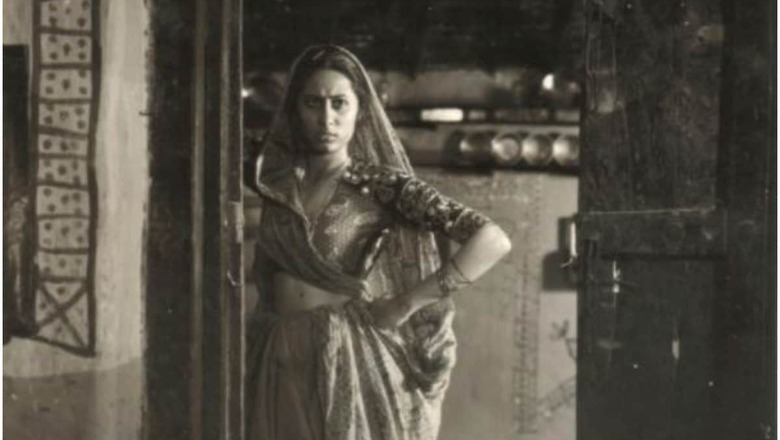
views
Cinema, over the last century, has welded itself into the cultural narrative, achieving an impact that no other singular medium could. It arrested the eyes, ears and mind and transported us to newer worlds and the new worlds to us. Cinema changed how stories were told and consumed forever. Indian films and their songs have subliminally defined the societal landscape at times reflecting it and at others, shaping it- often for the better but sometimes for, the worse. Its force and its fault lines are fascinating.
Today, questions have arisen about the increasingly unsavoury aspects of the film industry, and in particular, Bollywood. Some are pleased that the feet of clay are revealed whilst others piqued that the film industry is treated as a soft target, a means of distraction from broader issues. Let’s understand more intricately why Cinema related issues have become increasingly polemical.
What’s Different
Is there something different about cinema, i.e. the entertainment industry compared to other industries? The answer is a resounding yes. One cannot equate with other industries for its products are unique–a result of various layers drawn from society; its ingredients not easily quantifiable, its themes and content are edgier, deeper. It’s intrinsically linked to life and reflects its contextuality.
Other consumer products steer clear of making radical statements and navigate the softer fuzzier world. But cinema, as the leading popular culture driver, thrives on live issues. It makes use of the socio-cultural environment and has an impact on the market and minds.
Here, don’t lose sight of the word market- for films are a product with a balance sheet. It’s not self-expression or pure artistic endeavour alone. We are talking of a carefully packaged commercial art product for the consumer.
Is our current cinema- largely an entertainment industry commercial product- resting on a pedestal that is fragile and showing signs of crumbling in its present form?
If so, what could be the possible reasons of this dangerously near fall from grace?
For starters, let us cast a look at the source; from which this flow of cinema emerges.
Weakened Ties
Initially, cinema borrowed from mythology, folklore and some themes inspired by the western world.
And at its most evocative, it borrowed from fine arts and literature as the source material. Be it stories of Tagore, Premchand or other writers. Perhaps one is biased, but the ability of literature to tap into the soul of times is nuanced and deep. There was a relationship, a seamlessness that cinema shared with literature.
The music and songs were inspired by many a fine artist–classical musicians, poets of calibre and dancers of repute. There was a certain humility in cinema where it learnt from the existing continuum of established subtler, art forms.
Of course, cinema was a new medium and had its more unique codes, and it was fast becoming a popular art form force to reckon with. As the demand increased, so did the need for more stories, more content. Themes of art, literature, mythology which connected to every segment, began to become more escapist increasingly. Many a filmmaker alluded to cinema that must focus on the lowest common denominator. Sure, there was the parallel art cinema movement which enriched but was niche.
Arguably, hubris crept in. Many believed that cinema was self-sufficient and all-pervasive. Yes, the cinematic techniques saw great strides ahead, be computer graphics, SFX and shooting techniques. But as the form and craft evolved, content suffered. The chasm between fine arts, literature and cinema widened. Cinema’s scope grew, but its soul started to dim.
Perhaps the rapidly changing landscape of the media and entertainment industry could not provide the space for writers, poets, musicians and visionary makers to truly thrive. A loss for cinema in a way as the fine calibre of artists facilitate a synthesis of art and society. These gifted men and women of fine arts come from a reality which is unique, chequered, intense. They come with ‘Anubhoot Satya’ (first-hand truth). They are plugged in. And that’s the reason their works, their expressions and thoughts resonate, it’s the real stuff not gossamer.
Diminishing connects with the practioner of finer arts resulted in a disconnect with societal realities. People who made films were increasingly those who dared to, not necessarily who deserved to, make cinema. Barring the exceptions, the ‘himmat-walas not the ‘talent-walas’ ruled.
Navel Gazing
The Film industry has the potential to be a vast and diverse breeding ground of talent. Unfortunately, it started to become increasingly insular and repetitive. For there was one internal lens through which cinema was being made. I’m not worried about a particular lens but am concerned about it being the only defining lens.
Our complex and nuanced cultural and historical context got viewed from this singular lens–one which unmindfully distorted or misrepresented it many a time. We have more to offer than just songs, dances and hero-heroine-villain sagas. It’s sad to limit it, especially in a land that gave birth to defining civilisational thoughts.
More than 2000 movies are made per year, and if not even 20 over the last 100 years are worthy of being considered in the world’s best, we have much to think about.
Hiding behind the veneer of “we make films for our internal audience and cannot be understood by the world” and the refrain of “it’s entertainment” too won’t cut ice.
Films are not pure spectacle where an entertainer pulls a rabbit out of the hat or displays eye-popping jugglery. Cinema borrows from life, history, culture, relationships and societal dynamics. It would be dishonest to be disrespectful towards the same source – the people and society that it borrows from.
Increasingly, the industry stopped enriching itself from more extensive sources and also fell short of nurturing the real talent within. Whilst the technical level went up, exceptional content and thought-provoking ideas are rare to find.
Commerce Trumping Art
Sure, one saw some path-breaking work, but that was either a flash in the pan or an exception. Many concerned artists of the industry voiced this, but somehow these concern could not get tabled at the right platforms. We kept seeing that the bulk of the product was, unfortunately, mediocre that made Bollywood gravitate towards frivolity and increasingly celebrating the commerce rather than the art of a film.
Bollywood is an industry that defines popular culture. Here, one would think ideas, art, poetry and music would be passionately discussed in significant internal gatherings. Instead, strategies and tactics to publicise higher collections, dominate most conversations. The bean counters often outweigh content creators.
What was forgotten was that cinema and many professional industries that emanate from art could not be judged like other businesses, or balance sheet made chief spokesperson.
Cinema manifests its significance not only through the commerce it generates but reflects the culture of the society. It shapes minds, gives birth to dreams and stirs up imaginations. It is disappointing then that an industry which knowingly or inadvertently sidelined art often demands a carte blanche, a pure artistic license for a predominantly commercial product.
Core Diminished
Glamour quotient, lifestyle draws, milking the ‘star brand’ through endorsements or appearances at functions grew disproportionately. The divide is not so much about ‘insider versus outsider’ as it is between the talented and the untalented. Between the actor and the star. Between a visionary filmmaker and a chief coordinator. Between those who want to make cinema for the love of it rather than the glamour of it. No surprise then that the paraphrenia gets celebrated and the core neglected.
Hollow Drum Beats
Bollywood’s identity seemed conflicted: is it a grandiose spectacle, fizzy frothy and non-serious or is it purpose-driven, ideologically and morally anchored?
This conflict reflected in many a film award shows, where the emphasis was on the razzmatazz and not genuine awards, not on the deserving but the conveniently available. Often, mediocrity not pure talent, got celebrated,
There were a few who stood up, and asked for dignity to be restored. However, many within the industry encouraged this no holds barred entertainment focus.
The reflection of this confusion can be seen when it comes to the avatar of the film stars off-screen, on serious societal issues.
Audiences also got confused when they see those from a mostly commerce focused entertainment-driven film industry vociferously raise a voice for or against social issues. And then rapidly run out of depth.
Sure, each citizen has a right to speak up, but to do so on public platforms sans in-depth understanding of the issue and its impact, needs an honest relook. For not only does it do injustice to the real problem, but also, instead of building the star brand, confuses the brand in the minds of the people.
There could also be a misreading of what building a brand or a star brand truly means. Projected reality is only momentarily impactful, gimmicks have a concise shelf life. Real gravitas cannot be gained from opportunistic projection.
Way Ahead
At this juncture, a lot of dirt is being flung and dirty linen being washed and issues raised.
Question is where does Bollywood go from here?
For starters, we have to be introspective as an industry and be ready to analyze critically. At the same time, we can’t throw the baby out with the bathwater.
Cinema has given us icons; it has immortalised great stories, stuck chords and moved masses, contributed in times of need. Besides, all cannot be tarred by the same brush. There are brilliant filmmakers, writers, actors, musicians, technicians, hard-working crew members who slog to bring forth 2.5 hours of entertainment for the audiences.
And yes, filmmaking, like many other creative fields, requires leeway. Of being square pegs in round holes, being lost in creation, being connected to a magical artistic universe. And that of at times, straying from the course.
But creative license needs to be responsibly utilised. To insensitively disparage indigenous culture, turn a blind eye to the exploitation of women, or corrupt children with age-inappropriate content, cannot be the course of real artists.
More than the angry, but myopic defenders, and conspiracy theorists of vendetta, we need the real well-wishers who do not flinch, introspect and course-correct. As I’d written in another context ‘Mujhe khud ko bhi hai tatolna, hai kami toe hai bolna, daag hain toe chupyae kyun, sach se nazrein hatayein Kyun.”
Be it to ensure the flow of funds from the right sources, the state of women, pay parity, or interests of the daily wage workers and their safety and security issues on the sets.
Let this largely self-inflicted wound not be the final act for a field as richly diverse and pregnant with possibilities as cinema.
Bollywood knows its strengths and weaknesses and is capable of making corrections where it genuinely feels it has gone wrong. There are industry bodies and many a forum where issues are raised and attempts made for a fair resolution. Sure, these can work more efficiently and in a more coordinated manner, but it would not be right to believe that all systems are broken.
Mirror Mirror
Many are deriving twisted pleasure from seeing the angst that Bollywood is going through. I would sincerely urge that people not give in to basal instincts.
This is a good time to introspect for the audience as well. There has to be a saner ground between the hysterical adulation and the sneering pulling down of screen idols. If the lines between on-screen and off-screen heroes are blurred willingly by the society, it is by no means the fault of the film industry.
Making the mediocre products boom at the box office, or dancing to the very same songs in family weddings whilst publically criticising them for objectification of women, is only hypocrisy. Shelling out money and time for shallow ‘leave your brains behind’ movies and expecting the same makers to spout words of profound wisdom on a complex socio-political issue, is perhaps unfair.
The purity of expression, artistic integrity and excellence needs to look up to, not lifestyle cues and the glamour quotient alone. Reject the unwanted, but please stay receptive to the uplifting work that cinema has to offer.
Let art and talent be the core, and we will see cinema shine brighter and enrich the creator and the audience alike.
(The Author is a lyricist, screenwriter, and the chairperson of the Central Board of Film Certification. He is also the CEO of McCann World Group India and Chairman (Asia Pacific). Views expressed are personal.)



















Comments
0 comment